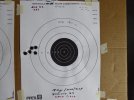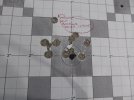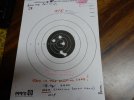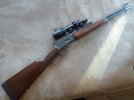You are using an out of date browser. It may not display this or other websites correctly.
You should upgrade or use an alternative browser.
You should upgrade or use an alternative browser.
Another horrible day with the 1894 44 mag.
- Thread starter Will
- Start date
Ricochet
Member
I was in the original group buy for the Ranch Dog 265 grain (275 as I cast them) 6 hole mould, and bought the .432" sizer from him with it. As I recall, he designed that bullet to work in .444 Marlin rifle Microgroove barrels. He said that the key to getting cast bullets to shoot in Microgroove bores was sizing them large. My intention was to shoot them in my 1970 Microgroove Model 94 .44 Magnum. Funny, I still haven't gotten around to trying that. But that bullet over 18.0 grains of Accurate #9 burning rate WC820 is my go-to full power load in .44 Magnum revolvers. I dip lube them in bulk Alox 606 (=LLA) as Ranch Dog did and recommended, or hand brush it onto the TL microbands.
Missionary
Well-Known Member
We have several Marlins and a couple were "fun" figuring out.
Our 41 mag defied all our attempts. Someone had written about a Rossi that was equally stubborn. So he stripped off all off the front but the barrel. Rifle shot great. Then returned the parts in reverse order doing proper parts fitting.
Worked on our 41 Marlin.
Our 41 mag defied all our attempts. Someone had written about a Rossi that was equally stubborn. So he stripped off all off the front but the barrel. Rifle shot great. Then returned the parts in reverse order doing proper parts fitting.
Worked on our 41 Marlin.
Charles Graff
Moderator Emeritus
I don't recall if I posted this before, but I have a Marlin 44 Mag like the one in question, and it shoots cast quite well. The twist and grove diameter are problematic for 44 magnum loads. Marlin just took the old 44-40 twist and put it in a large MG barrel. I load it like a 44-40. I used an old discontinued RCBS 210 grain gas check mold and shoot the bullets .432. I used a powder charge of 10 grains of Unique and get 4" 100 yard groups. Shoot heavier (i.e. longer), smaller or faster loads and accuracy goes to hell real quick you betchem.Anyone read the Brian Pearce article in the recent Rifle magazine about this very subject? Swapped to a 1-16 twist and had the action worked over to allow feeding of up to 340 grain bullets. Accuracy chart before and after shooting same loads. Marlin just needs to change the twist rate on these.
If a fellow can live with a modern 44-40 levergun using 44 Mag. cases, the Marlin is a good one to have. S0metimes you have to go with what you have to be happy. Despite all my efforts, my first wife never did look like Raquel Welch.
Last edited:
Snakeoil
Well-Known Member
Love Missionary's approach. Remove all the variables and then work backwards. I think the lever guns get a bad wrap when it is really not the action type that causes the problems, but other issues. I read almost all the posts here so let's list what has been brought up.
Twist rate is meant for a short, slow bullet.
Dovetail cuts can cause tight spots in the bore.
Forend it touching the barrel
Ammo moving inside the magazine tube changing recoil direction
Various attachments, mag tube, forend band, muzzle band all in some form of contact with the barrel.
Goofy scope
So, here is my 2 cents worth (probably worth about 1.2 cents in reality) on the subject.
First, I suspect that Marlin chose the slow twist because they knew that lead bullets would get shot in the rifle and being micro-groove, a faster twist might just strip out on fast moving lead bullets. So, to the points made by others, slow down the bullet and reduce the size to something like a .44-40 slug. I would lean towards a softer alloy like 20:1 or even 30:1 and prefer a true PB bullet to assure a good seal, and not a bevel-base bullet.
At this point, although this is a lever gun with a tubular mag, I would not use a crimp. I would simply use about 0.002 neck tension while you are trying to get the rifle to shoot. A crimp is just another variable that is not easy to control. If your crimp is not uniform, unless you mark the cases and index them in the press and when chambering them, a non-uniform crimp will be randomly positioned in the chamber for every shot.
Nobody has mentioned the muzzle crown. Looking at your targets, I see no pattern to any of the groups, regardless of size. They seem to be very random. There is one exception, two targets have a cluster of 3 or so at the top and then two flyers down below. The rest are pretty random. That would make me think that the crown on the muzzle needs some work. If there is a slight burr, it will tear the bullet and more than likely cause erratic departure from the muzzle along with erratic flight. I would check the crown with a 10x loupe and if at all in doubt, make a brass lap and make sure the crown is perfect. I'm not talking about angularity here. That will create a consistent change in point of impact. I'm talking about a burr, raised area and such from the machining process.
Next, I would try Missionary's suggestion of stripping down the rifle to just the barrel and action. Always rest the barrel in the same spot on your bag. Even if you don't get the load right, if you use a smaller bullet at reduced velocities, at 50 yds you should be able to shoot a decent sized group. Even if you took the scope off (to remove that variable) you should be able to shoot a decent group at 50 yds with iron sights assuming that you don't have geezer eyes and can shoot iron sights. If the rifle will not shoot stripped down to its basic parts, then you need to look deeper. Running a slug down the bore to check for tight spots would probably be my next move. I'd lap the barrel with JB Bore paste while I was at it. Then if there are no high spots, no muzzle burrs and your scope is proven good, I would pick a powder like 2400 or Unique and do a ladder test using the same short, light bullet. I'd start with 1/2 grain increments. And as much as I love 2400, I might hold off and stay with faster pistol powders given the reduced velocity. You want a harder smack in the ass to have the PB fill the bore and seal rather than a push from a magnum type powder.
And that last point brings up one last though. If you have a GC bullet you can shoot in the rifle, I'd give that a try to see if it makes a difference. If it will shoot well with a GC bullet, then it's telling you that you need to find the sweet spot to shoot a PB bullet.
Twist rate is meant for a short, slow bullet.
Dovetail cuts can cause tight spots in the bore.
Forend it touching the barrel
Ammo moving inside the magazine tube changing recoil direction
Various attachments, mag tube, forend band, muzzle band all in some form of contact with the barrel.
Goofy scope
So, here is my 2 cents worth (probably worth about 1.2 cents in reality) on the subject.
First, I suspect that Marlin chose the slow twist because they knew that lead bullets would get shot in the rifle and being micro-groove, a faster twist might just strip out on fast moving lead bullets. So, to the points made by others, slow down the bullet and reduce the size to something like a .44-40 slug. I would lean towards a softer alloy like 20:1 or even 30:1 and prefer a true PB bullet to assure a good seal, and not a bevel-base bullet.
At this point, although this is a lever gun with a tubular mag, I would not use a crimp. I would simply use about 0.002 neck tension while you are trying to get the rifle to shoot. A crimp is just another variable that is not easy to control. If your crimp is not uniform, unless you mark the cases and index them in the press and when chambering them, a non-uniform crimp will be randomly positioned in the chamber for every shot.
Nobody has mentioned the muzzle crown. Looking at your targets, I see no pattern to any of the groups, regardless of size. They seem to be very random. There is one exception, two targets have a cluster of 3 or so at the top and then two flyers down below. The rest are pretty random. That would make me think that the crown on the muzzle needs some work. If there is a slight burr, it will tear the bullet and more than likely cause erratic departure from the muzzle along with erratic flight. I would check the crown with a 10x loupe and if at all in doubt, make a brass lap and make sure the crown is perfect. I'm not talking about angularity here. That will create a consistent change in point of impact. I'm talking about a burr, raised area and such from the machining process.
Next, I would try Missionary's suggestion of stripping down the rifle to just the barrel and action. Always rest the barrel in the same spot on your bag. Even if you don't get the load right, if you use a smaller bullet at reduced velocities, at 50 yds you should be able to shoot a decent sized group. Even if you took the scope off (to remove that variable) you should be able to shoot a decent group at 50 yds with iron sights assuming that you don't have geezer eyes and can shoot iron sights. If the rifle will not shoot stripped down to its basic parts, then you need to look deeper. Running a slug down the bore to check for tight spots would probably be my next move. I'd lap the barrel with JB Bore paste while I was at it. Then if there are no high spots, no muzzle burrs and your scope is proven good, I would pick a powder like 2400 or Unique and do a ladder test using the same short, light bullet. I'd start with 1/2 grain increments. And as much as I love 2400, I might hold off and stay with faster pistol powders given the reduced velocity. You want a harder smack in the ass to have the PB fill the bore and seal rather than a push from a magnum type powder.
And that last point brings up one last though. If you have a GC bullet you can shoot in the rifle, I'd give that a try to see if it makes a difference. If it will shoot well with a GC bullet, then it's telling you that you need to find the sweet spot to shoot a PB bullet.
Winelover
North Central Arkansas
I don't recall if I posted this before, but I have a Marlin 44 Mag like the one in question, and it shoots cast quite well. The twist and grove diameter are problematic for 44 magnum loads. Marlin just took the old 44-40 twist and put it in a large MG barrel. I load it like a 44-40. I used an old discontinued RCBS 210 grain gas check mold and shoot the bullets .432. I used a powder charge of 10 grains of Unique and get 4" 100 yard groups. Shoot heavier (i.e. longer), smaller or faster loads and accuracy goes to hell real quick you betchem.
If a fellow can live with a modern 44-40 levergun using 44 Mag. cases, the Marlin is a good one to have. S0metimes you have to go with what you have a be happy. Despite all my efforts, my first wife never did look like Raquel Welch.
w


NOE's 265 RF ( RD clone with lube grooves) over 16.0 grains of 2400

I get good groups with a range of three different bullet weights, 210, 265 & 300 grains, in my Marlin. Common denominator is to size at .433 diameter, use 2400 powder and neck size the brass. Albeit, the 210 has the edge in accuracy, but the heavies are no slouch.

Last edited:
JonB
Halcyon member
What a eloquent and concise way to put it.I don't recall if I posted this before, but I have a Marlin 44 Mag like the one in question, and it shoots cast quite well. The twist and grove diameter are problematic for 44 magnum loads. Marlin just took the old 44-40 twist and put it in a large MG barrel. I load it like a 44-40. I used an old discontinued RCBS 210 grain gas check mold and shoot the bullets .432. I used a powder charge of 10 grains of Unique and get 4" 100 yard groups. Shoot heavier (i.e. longer), smaller or faster loads and accuracy goes to hell real quick you betchem.
If a fellow can live with a modern 44-40 levergun using 44 Mag. cases, the Marlin is a good one to have. S0metimes you have to go with what you have a be happy. Despite all my efforts, my first wife never did look like Raquel Welch.
w
.
I had a JM Marlin 1894 44 mag. I had accuracy issues with heavy cast bullets, but would shoot my oversize Lee 200gr RF just dandy. Somewhere along the way, I learned about the groove dia and twist rate issue. When the subject would come up, I've told many people about these issues, but somehow, I always get into the weeds describing more of my experience, than a short little explanation like this.
CZ93X62
Official forum enigma
If I get 3" groups from my leverguns at 100 yards I am pretty happy. That is all that I really expect. About a decade back I bought a gorgeous mid-1950s Marlin 336 from the late Cobb Mtn. Mac. It is a 2/3 magazine variant with pistol-grip stock. It will stack both #311041 and #311291 into 1.3" to 1.5" groups all day at 100 yards, at 1700-2000 FPS. There is NOTHING ON EARTH like a fat, high-velocity sweet spot on a nice rifle. I have had a half-dozen 30/30 leverguns over the years, but Mac's rifle is certainly Best Of Breed.
An added bonus is the memories of that fine man that handling and firing his rifle provide. Requiescat in pacem.
An added bonus is the memories of that fine man that handling and firing his rifle provide. Requiescat in pacem.
Snakeoil
Well-Known Member
I know the subject is .44 and micro-groove. But I have a Marlin Cowboy in .45LC. I've never checked the twist but know that it has cut, Ballard rifling. I cannot remember if I ever put it on paper. All I ever shot out of it was bevel base, commercially cast (rock hard) bullets. I don't think there is a better rifle for CAS than that Cowboy. I can make that thing sound like a semi-auto and sweep a series of targets and never miss. Of course, they are probably 8 inch targets set at something around 15 or maybe 20 yds. I probably need to dig that rifle out and take it to the range and put it on paper. Iron sights only though.
I had a similar problem when finding the best load for my Marlin 94. I couldn’t find an accurate load at all, with 5 or 6 different bullets. Then I remembered that it shot very well when I used it for cowboy action competitions. Duh, light bulb. I took scope off and started shooting decent groups at 50 yds with iron sights. 1 1/2” groups from a rest are the best I can do with standard iron sights with any rifle I own. Peep sights are a bit better, but the light has to be good. I think it was the detachable, Warne, scope Mount on a standard base. I’ve read they don’t match up correctly. Will shoot some tomorrow and find out. HarlesSorry about your 94 but I love your shooting bench.
Winelover
North Central Arkansas
Almost all my rifles/carbines use Warne or Luepold QD levers................because I have optional scopes/red dots/reflexes for each. Never had an accuracy issue. BTW, I never lapped any scope rings, either. I switched to Warne because Kimber discontinued their svelte double lever scope rings, when they went out of business on the west coast. Warne offers QD levers that fit on Kimber bases. My Redhawk has a D&T Kimber base that's low enough to use the factory open sights.............as does my TC Renegade.I had a similar problem when finding the best load for my Marlin 94. I couldn’t find an accurate load at all, with 5 or 6 different bullets. Then I remembered that it shot very well when I used it for cowboy action competitions. Duh, light bulb. I took scope off and started shooting decent groups at 50 yds with iron sights. 1 1/2” groups from a rest are the best I can do with standard iron sights with any rifle I own. Peep sights are a bit better, but the light has to be good. I think it was the detachable, Warne, scope Mount on a standard base. I’ve read they don’t match up correctly. Will shoot some tomorrow and find out. Harles
I went to shooting range Saturday. Got much better results after scope ring change. I could only shoot 25 yards, but got near one hole groups with both loads I used. Not faulting Warne rings at all, just need to have correct bases for them. I plan to get skinner peeps made for them to use on my Model 95 cowboy in 45-70.Almost all my rifles/carbines use Warne or Luepold QD levers................because I have optional scopes/red dots/reflexes for each. Never had an accuracy issue. BTW, I never lapped any scope rings, either. I switched to Warne because Kimber discontinued their svelte double lever scope rings, when they went out of business on the west coast. Warne offers QD levers that fit on Kimber bases. My Redhawk has a D&T Kimber base that's low enough to use the factory open sights.............as does my TC Renegade.
I don't have a 94 any more, but a dear friend does, and I cast the RDO 265 for him. I size to .432"+ and tumble-lube, using 45-45-10, home-made gas checks and he is tickled pink with the thing. I've never asked about group size, but he seems plenty leased with it and he's kind of a picky guy.
I don't use the mould for anything I shoot, so I need to pack it up and send it to him. If I were to win the lottery, I'd send him a pot and all the other do-dads we all like for casting too.
Let the masses BUY ammo. The rest of us make what we want/need.
I don't use the mould for anything I shoot, so I need to pack it up and send it to him. If I were to win the lottery, I'd send him a pot and all the other do-dads we all like for casting too.
Let the masses BUY ammo. The rest of us make what we want/need.
